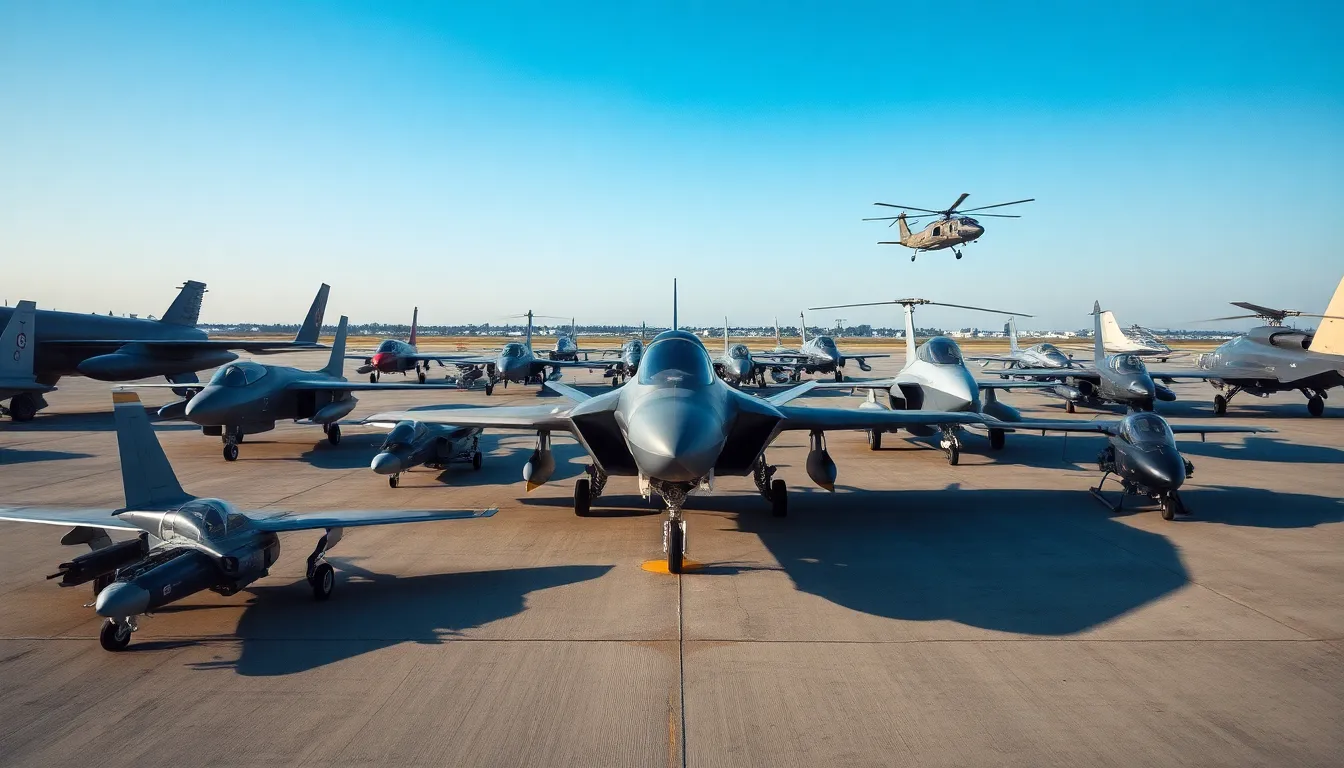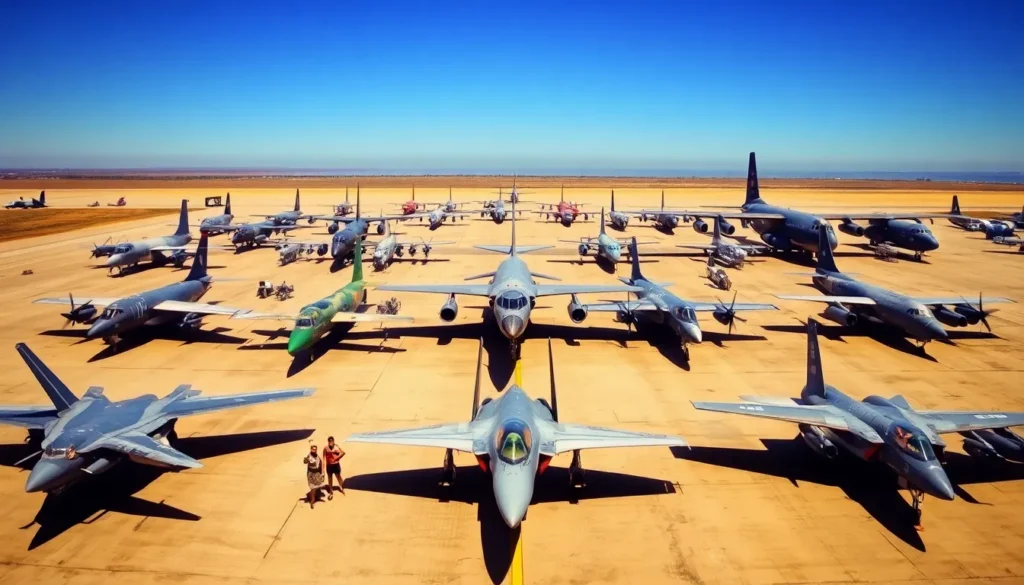Table of Contents
ToggleWhen it comes to aircraft, the United States has more than just a few tricks up its sleeve. With a fleet that could make even the most seasoned aviation enthusiast do a double-take, the numbers are nothing short of impressive. From sleek fighter jets to sturdy cargo planes, the U.S. boasts a diverse array of aircraft that serve various purposes—from national defense to delivering pizza (okay, maybe not that last one, but you get the idea).
Overview of U.S. Aircraft Inventory
The U.S. possesses a substantial aircraft inventory, comprising over 13,000 military aircraft. This fleet includes diverse categories such as fighter jets, transport planes, and helicopters. Notably, the U.S. operates approximately 2,500 fighter aircraft, which include the advanced F-35 Lightning II and the F-22 Raptor.
Cargo planes make up a significant portion of the inventory, with around 1,000 aircraft dedicated to logistical support. The C-130 Hercules and the C-17 Globemaster III play crucial roles in transporting troops and equipment. Furthermore, the fleet comprises over 900 rotary-wing aircraft, including the Apache and Black Hawk helicopters, which excel in troop movement and support missions.
Maintenance of these aircraft demands significant resources. The total operating budget for this aircraft inventory exceeds $200 billion annually. Enhanced technology and upgrades ensure the U.S. fleet remains formidable in capabilities and readiness.
U.S. aircraft serve various functions beyond military operations. Many support humanitarian efforts and disaster relief missions. Examples include the use of cargo aircraft to deliver supplies during natural disasters.
A continual emphasis on modernization reflects in the growing number of unmanned aerial vehicles (UAVs). Currently, the U.S. has around 1,000 UAVs, including the MQ-9 Reaper, which offers advanced surveillance and strike capabilities.
Overall, the aircraft inventory showcases the U.S. commitment to maintaining a versatile and powerful fleet. This array of aircraft not only enhances national security but also illustrates the innovative spirit of U.S. aviation.
Military Aircraft in the U.S.

The U.S. maintains a comprehensive fleet of military aircraft essential for national defense. This diverse inventory serves various functions, including combat, transport, and surveillance.
Types of Military Aircraft
The U.S. military category includes several aircraft types, each designed for specific missions. Fighter jets like the F-35 Lightning II and F-22 Raptor excel in air superiority. Cargo aircraft such as the C-130 Hercules and C-17 Globemaster III facilitate troop and supply transport. Additionally, helicopters, including the Apache and Black Hawk, provide versatile support in various operations. Unmanned aerial vehicles, notably the MQ-9 Reaper, enrich surveillance and strike abilities. These aircraft types enhance the military’s operational efficiency across multiple domains.
Total Number of Military Aircraft
The total military aircraft inventory of the U.S. exceeds 13,000 units. This count encompasses approximately 2,500 fighter jets, around 1,000 cargo planes, and over 900 helicopters. The fleet also includes around 1,000 unmanned aerial vehicles. Significant financial resources support these aircraft, with an annual operating budget surpassing $200 billion. This substantial investment is indicative of the U.S. commitment to sustaining a formidable, modern aviation capability that meets diverse operational requirements.
Civilian Aircraft in the U.S.
The United States possesses a vast array of civilian aircraft, playing a critical role in transportation, cargo, and leisure activities.
Commercial Aviation Fleet
The commercial aviation fleet in the U.S. comprises approximately 7,000 aircraft. Airlines utilize these planes for domestic and international travel. Among them, Boeing and Airbus dominate the market with models like the Boeing 737 and Airbus A320. Major airlines such as American, Delta, and United operate large portions of this fleet. These aircraft transport millions of passengers annually, contributing significantly to the economy.
General Aviation Aircraft
General aviation refers to the wide-ranging category of civil aviation that includes all non-commercial flights. This sector includes around 200,000 aircraft in the U.S., comprising private planes, helicopters, and business jets. Pilots use general aviation for personal travel, flight training, and agricultural activities. Models like the Cessna 172 and Cirrus SR22 stand out for their popularity among private pilots. This diverse fleet enhances connectivity and accessibility, serving a variety of community needs.
Historical Context of U.S. Aircraft Numbers
Aircraft numbers in the U.S. reflect historical trends shaped by military and civilian needs. Understanding these trends provides insight into how the fleet evolved over time.
Trends Over the Decades
The number of military aircraft has fluctuated based on defense strategies and technological advancements. In the 1950s, the U.S. military began transitioning to jet aircraft, leading to over 18,000 military aircraft by the decade’s end. The post-Cold War era saw significant reductions, with the total dropping to around 8,000 by the 1990s. Recent years demonstrate a resurgence in numbers, driven by advances such as the F-35 Lightning II and increasing global security needs, elevating the fleet to over 13,000 military aircraft. Civilian aircraft numbers also changed, with the commercial sector growing from only a few hundred in the 1920s to approximately 7,000 modern aircraft today, driven by increased travel.
Major Events Impacting Aircraft Inventory
World War II dramatically increased military aircraft production. During the war, production soared to a peak of around 300,000 aircraft. The Korean War further expanded the fleet, prompting rapid advancements in technology and capabilities. Events like 9/11 and the subsequent War on Terror heightened the focus on modernizing the aircraft inventory. Emphasis on unmanned aerial vehicles (UAVs) surged during this period, with around 1,000 UAVs currently enhancing surveillance and strike operations. Similarly, deregulation in the late 1970s transformed civil aviation, fostering competition and innovations, thus shaping the current landscape of roughly 200,000 general aviation aircraft.
The extensive fleet of aircraft in the United States reflects a robust commitment to both military readiness and civilian aviation. With over 13,000 military aircraft and approximately 7,000 commercial planes, the U.S. maintains a significant presence in the global aviation landscape. This diversity not only enhances national defense capabilities but also supports vital economic activities and community needs.
As the aviation sector continues to evolve with technological advancements and changing geopolitical landscapes, the importance of maintaining and modernizing this fleet remains paramount. The U.S. will likely continue to adapt its aviation strategies to meet emerging challenges and opportunities, ensuring a strong and versatile air capability for years to come.




